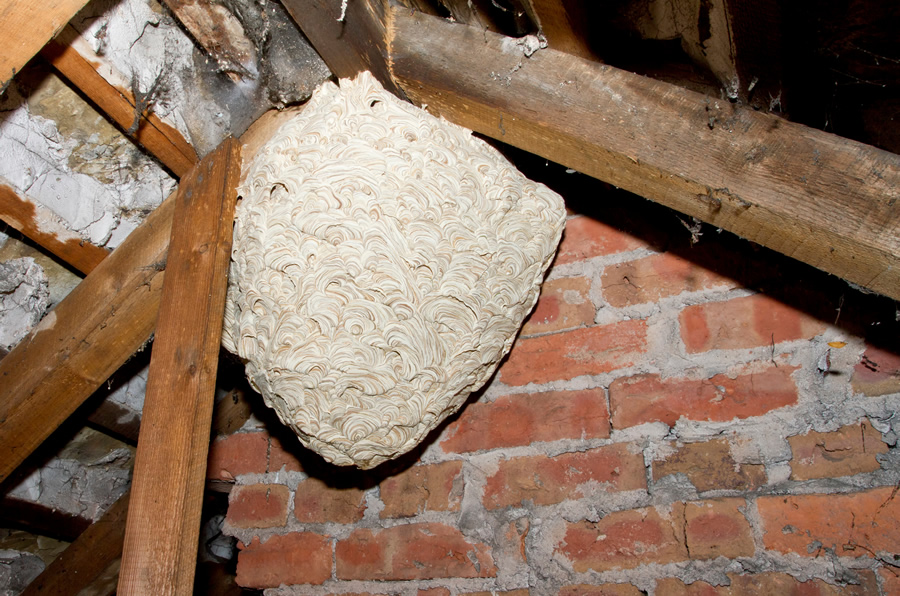Discovering a wasp nest on your property can be a daunting experience, but with the right knowledge and precautions, you can safely and effectively handle the situation. In this comprehensive guide, we will walk you through the process of identifying, removing, and preventing wasp nests.
Identifying Wasp Nests

Before you can tackle a wasp nest, it’s crucial to determine the type of wasps you’re dealing with and where they’ve built their nest. Common species include:
1. Yellowjackets (Vespula spp.)
Yellowjackets are recognizable by their bright yellow markings and often construct their nests underground.
2. Paper Wasps (Polistes spp.)
Paper wasps create open, umbrella-shaped nests that hang from eaves, branches, or other sheltered structures.
3. Bald-Faced Hornets (Dolichovespula maculata)
Bald-faced hornets are larger and have black bodies with distinct white markings. They build large, hanging nests, typically in trees or on buildings.
Safety Precautions
Safety is paramount when dealing with wasp nest removal. Take these precautions to protect yourself:
Protective Gear: Wear long sleeves, pants, gloves, and a face mask or veil to shield yourself from stings.
Timing: Conduct the removal during early morning or late evening when wasps are less active and mostly inside the nest.
Choosing a Removal Method
Several methods can be used for wasp nest removal, depending Wasp nest removal on the nest’s location and size:
1. Chemical Sprays
Insecticides designed for wasp nest removal are available at most hardware stores. To use them effectively:
Apply the insecticide directly into the nest entrance during the evening when wasps are less active.
Always follow the manufacturer’s instructions closely.
2. Freezing
Freezing the nest using CO2 or a similar substance can immobilize the wasps, making removal safer.
3. Professional Pest Control
For large nests, nests in hard-to-reach areas, or if you’re uncomfortable handling the task, consider hiring professional pest control services. They have the expertise and equipment for safe and effective wasp nest removal.
Removing the Nest
Once you’ve successfully eliminated the wasp colony, follow these steps to remove the nest:
Approach with Caution: Even after treatment, some wasps may remain alive but weakened. Approach the nest slowly and avoid sudden movements.
Detach Carefully: Use a long stick or scraper to gently detach the nest from its attachment point. Ensure you remove the entire nest.
Disposal
Proper disposal is essential to prevent any surviving wasps from rebuilding the nest. Take these disposal steps:
Use a Plastic Bag: Place the removed nest into a plastic bag and seal it securely.
Dispose Properly: Put the sealed bag in an outdoor trash bin, preferably away from your home.
Preventing Future Nests
To minimize the chances of future wasp nests on your property, consider these preventive measures:
Seal Entry Points: Seal gaps, cracks, and holes in your home’s walls and eaves to prevent wasps from nesting.
Install Screens: Use mesh screens on windows and vents to keep wasps out.
Food and Drink: When outdoors, keep food and sweet beverages covered to avoid attracting wasps.
Decoy Nests: Hanging decoy nests can deter wasps from building real nests in the same area.
Conclusion
Wasp nest removal is a task that requires knowledge and caution. By following the steps outlined in this guide and taking appropriate safety measures, you can effectively eliminate wasp nests and ensure the safety of your family and property. If you’re uncertain about handling a wasp nest, especially if it’s large or in a difficult location, it’s advisable to seek professional pest control services. They have the expertise to ensure a wasp-free environment, allowing you to enjoy your outdoor spaces without worry.
Don’t let wasps disrupt your peace. Take action today and regain control of your surroundings.